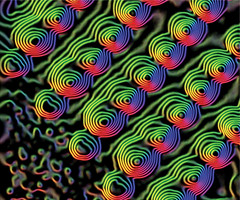 一個奈米科技(nanotechnology)研究團隊研發出可經由生物分解的救命粒子,其可將藥物傳遞至肺部或是滲透進癌細胞中,但同時卻不會接觸到健康的細胞。
一個奈米科技(nanotechnology)研究團隊研發出可經由生物分解的救命粒子,其可將藥物傳遞至肺部或是滲透進癌細胞中,但同時卻不會接觸到健康的細胞。
僅只100到300奈米單位,比一根頭髮還要細100倍,這些奈米微粒可裝載藥物或顯影劑,如黃金可提高醫療檢測項目的功能,例如電腦斷層掃描(CT scans)與核磁共振攝影(MRIs.)。
普林斯頓大學化學工程教授,同時身兼科學家研究團隊主任的普德翁(Robert Prud'homme)表示,「材料科學與化學兩者的交集,使不可能化為可能。」明尼蘇達大學與愛荷華州立大學也同樣得到的國家科學基金會(National Science Foundation) 資助。普德翁補充,「從未有人能夠成功合併藥物與顯影劑到奈米微粒中,」而所謂的奈米微粒是以10億分之一為計量單位。這位教授將於11日在一場演講中,發表此科研團隊的研究成果。這場演講安排在美國國家科學院於華盛頓特區舉行的會議中,會議主題為關於奈米材料在生物及藥物應用。
這項稱之為快閃奈米沈降法(Flash NanoPrecipitation)的新科技,將使研究人員能將藥物與物質混和之後進行壓縮。
A nanotechnology research team has created biodegradable lifesaving particles that can deliver medicine deep into the lungs or infiltrate cancer cells while leaving normal ones alone.
Only 100 to 300 nanometers wide - more than 100 times thinner than a human hair - the nanoparticles can be loaded with medicines or imaging agents, like gold, that will enhance the detection capabilities of medical tests such as CT scans and MRIs.
"The intersection of materials science and chemistry is allowing advances that were never before possible," said Robert Prud'homme, a Princeton chemical engineering professor and the director of the team of scientists at Princeton, the University of Minnesota and Iowa State University funded by the National Science Foundation.
He said, "No one had a good route to incorporate drugs and imaging agents in nanoparticles," which are particles measured in billionths of meters.
Prud'homme will present the team's research April 11 in a talk titled "How Size Matters in the Retention of Nanomaterials in Tissue," to be given at the National Academy of Sciences meeting on Nanomaterials in Biology and Medicine in Washington, DC.
The new technique, called Flash NanoPrecipitation, allows the researchers to mix drugs and materials that encapsulate them.
全文及圖片詳見 ENS報導






